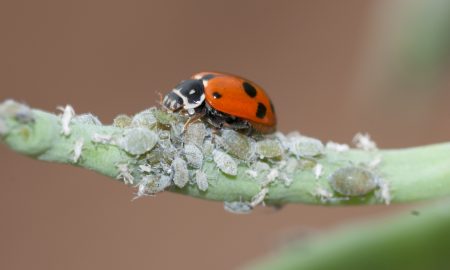Blue oat mites have been particularly active in cereals in northern NSW; reports include two chemical control failures.
Where have they been reported?
In the Central West Slopes & Plains of NSW, two oat crops in the Quirindi area have been damaged by a species of blue oat mite (Penthaleus spp.) that later proved difficult to control with a synthetic pyrethroid. The mites were subsequently controlled with omethoate.
In the south of that district, near Wellington, blue oat mites have become common in several late sown wheat crops, several of which were sprayed.
Blue oat mites have also become evident in oats near Tamworth, in the North West Slopes & Plains, after good rains and a sudden frost. Chemical, control has not been necessary in this situation.
Additionally, blue oat mites have been observed in several other parts of NSW and are active in Victoria.
About blue oat mites
Blue oat mites can be distinguished from other mites by their blue-black coloured body and characteristic red mark on their back.
They are often mistaken for redlegged earth mites (Halotydues destructor, RLEM) due to their similar appearance and sympatric life cycle, although RLEM have jet-black bodies and lack any such red marking.
Blue oat mites comprise a group of at least three species. A microscope is required to distinguish the morphological differences between Penthaleus major, Penthaleus falcatus and Penthaleus tectus.
The species that experienced control failures near Quirindi was not identified, although it is likely to be either P. falcatus or P. tectus.
P. falcatus prefers canola crops, but will also attack cereals, pastures and even broad-leafed weeds. Importantly, this species has a significantly higher tolerance to pyrethroids and organophosphates than other blue oat mite species and the RLEM.
P. tectus has a preference for cereals and is known to be common in northern NSW, but we have not previously had reported chemical failures of this species.
Refer to the blue oat mite PestNote for further information.
Our advice
Monitor emerging crops and pastures (particularly later sown crops) for the presence of mites. If mites are found attacking plant seedlings, determine the species before deciding on the most appropriate management option. A reminder that RLEM are typically not found further north than Dubbo, in NSW.
If blue oat mites are identified and chemical control is warranted, ensure insecticide sprays are applied at the full registered rate. This is particularly important when targeting blue oat mites in emerging canola crops. Economic thresholds established for RLEM in canola are a reasonable guide for blue oat mites.
Acknowledgements
Sources of field reports of blue oat mites
Mick Duncan – Agronomist, Northern Agriculture (NSW North West Slopes & Plains)
Glen Shepherd – Agronomist, IMAG Consulting (NSW Central West Slopes & Plains)
Hugh Urquhart – Agronomist, NU Rural (NSW Central West Slopes & Plains)
Cover image: Photo by Andrew Weeks, Cesar Australia





